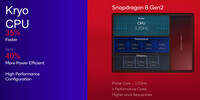Apple M3 Max 14-Core vs Qualcomm Snapdragon 8 Gen 2 for Galaxy vs Apple M3 Max 16-Core
Apple M3 Max 14-Core
► remove from comparison
The Apple M3 Max 14 core CPU is a system on a chip (SoC) from Apple for notebooks that was introduced towards the end of 2023. It integrates a new 14-core CPU with 10 performance cores with up to 4.06 GHz and 4 efficiency cores with 2.8 GHz. There is also a more powerful 16-core variant with 40 GPU cores.
Thanks to the higher clock rates and architectural improvements, the processor performance is also significantly better than the M2 Max in benchmarks and can keep up with the fastest mobile CPUs.
The M3 also integrates a new graphics card with dynamic caching, mesh shading and ray tracing acceleration via hardware. In the cheaper model, 30 of the chip's 40 cores are used and support up to 5 displays simultaneously (internal and 4 external).
GPU and CPU can jointly access the shared memory on the package (unified memory). This is available in 36 and 96 GB variants and offers 400 GB/s maximum bandwidth (512 bit bus).
The integrated 16-core Neural Engine has also been revised and now offers 18 TOPS peak performance (compared to 15.8 TOPS in the M2 but 35 TOPS in the new A17 Pro). The video engine now also supports AV1 decoding in hardware. H.264, HEVC and ProRes (RAW) can still be decoded and encoded. Like its predecessor, the Max chip offers two video engines and can therefore encode and decode two streams simultaneously.
Unfortunately, the integrated WLAN only continues to support WiFi 6E (no WiFi 7), unlike the small M3 SoC thunderbolt 4 is also supported (max 40 Gbit/s).
The chip is manufactured in the current 3nm process (N3B) at TSMC and contains 92 billion transistors (+37% vs. Apple M2 Max).
Qualcomm Snapdragon 8 Gen 2 for Galaxy
► remove from comparison
The Qualcomm Snapdragon 8 Gen 2 for Galaxy Mobile Platform is a high-end SoC for smartphones that was introduced in late 2022 and manufactured in 4 nm at TSMC (N4P). It integrates four different CPU clusters. A fast and big prime core based on the ARM Cortex-X3 architecture and clocked at up to 3.36 GHz for 64 bit applications. Two more ARM Cortex-A715 based performance cores clocked at up to 2.8 GHz (also only for 64 bit apps). Two more Cortex-A710 performance cores at up to 2.8 GHz that can also be used for older apps and three efficiency cores (ARM Cortex-A510 with up to 2 GHz). All cores can use the shared 8 MB level 3 cache. Compared to the normal SD 8 Gen 2, the "for Galaxy" version offers a 160 MHz higher clocked prime core.
Thanks to the new architecture and high clock rates, the SD 8 Gen 2 is the fastest mobile CPU for Android based devices and is only topped by current Apple SoCs like the Apple A16 (see benchmarks below).
The chip also integrates a Hexagon accelerator for AI workloads (tensor, scalar and vector). Qualcomm states that its one of the first chips with INT4 support and up to 4.35x performance compared to the previous generation.
The 18-Bit-Spectra ISP is able to process photos with up to 200 MP and work with videos up to 8k30 (including 10-bit, HDR10+, HLG and Dolby Vision).
A big improvement of the Snapdragon 8 G2 is the integrated Adreno 740 GPU, that now supports Hardware Raytracing and tops even the iGPU in the Apple A16.
The integrated AI Engine can offer up to 4x faster AI performance thanks to the bigger Tensor engine. The 18-Bit-Spectra-ISP also saw some big improvements and is now called Snapdragon Sight.
The integrated Adreno 730 offers a 30% graphics boost compared to the previous Adreno 660.
The integrated Snapdragon X70 5G modem is also new as is the FastConnect 7800 modem with Wi-Fi 7 and Bluetooth 5.3 support.
Apple M3 Max 16-Core
► remove from comparison
The Apple M3 Max (16 Core) is a system on a chip (SoC) from Apple for notebooks that was launched towards the end of 2023. It integrates a new 16-core CPU with 12 performance cores with up to 4.06 GHz and 4 efficiency cores with 2.8 GHz. There is also a slimmed-down 14-core variant with a 30-core GPU.
Thanks to the higher clock rates and architectural improvements, the processor performance is also significantly better than the M2 Max in benchmarks and can keep up with the fastest mobile CPUs (such as a Core i9-13900HX).
The M3 also integrates a new graphics card with dynamic caching, mesh shading and ray tracing acceleration via hardware. In the top model, all 40 cores of the chip are used and support up to 5 displays simultaneously (internal and 4 external).
GPU and CPU can jointly access the shared memory on the package (unified memory). This is available in 48, 64 and 128 GB variants and offers 400 GB/s maximum bandwidth (512 bit bus).
The integrated 16-core Neural Engine has also been revised and now offers 18 TOPS peak performance (compared to 15.8 TOPS in the M2 but 35 TOPS in the new A17 Pro). The video engine now also supports AV1 decoding in hardware. H.264, HEVC and ProRes (RAW) can still be decoded and encoded. Like its predecessor, the Max chip offers two video engines and can therefore encode and decode two streams simultaneously.
Unfortunately, the integrated WLAN only continues to support WiFi 6E (no WiFi 7), unlike the small M3 SoC thunderbolt 4 is also supported (max 40 Gbit/s).
The chip is manufactured in the current 3nm process (N3B) at TSMC and contains 92 billion transistors (+37% vs. Apple M2 Max). Under load, the CPU part consumes up to 56 watts, the chip can use a total of 78 watts.
| Model | Apple M3 Max 14-Core | Qualcomm Snapdragon 8 Gen 2 for Galaxy | Apple M3 Max 16-Core | ||||||||||||||||||||||||||||||||||||||||||||||||
| Series | Apple Apple M3 | Qualcomm Snapdragon | Apple Apple M3 | ||||||||||||||||||||||||||||||||||||||||||||||||
| Series: Apple M3 |
|
|
| ||||||||||||||||||||||||||||||||||||||||||||||||
| Clock | 2748 - 4056 MHz | 2000 - 3360 MHz | 2748 - 4056 MHz | ||||||||||||||||||||||||||||||||||||||||||||||||
| Cores / Threads | 14 / 14 10 x 4.1 GHz Apple M3 P-Core 4 x 2.7 GHz Apple M3 E-Core | 8 / 8 1 x 3.4 GHz ARM Cortex-X3 2 x 2.8 GHz ARM Cortex-A715 2 x 2.8 GHz ARM Cortex-A710 3 x 2.0 GHz ARM Cortex-A510 | 16 / 16 12 x 4.1 GHz Apple M3 P-Core 4 x 2.7 GHz Apple M3 E-Core | ||||||||||||||||||||||||||||||||||||||||||||||||
| TDP | 78 Watt | 78 Watt | |||||||||||||||||||||||||||||||||||||||||||||||||
| Transistors | 92000 Million | 92000 Million | |||||||||||||||||||||||||||||||||||||||||||||||||
| Technology | 3 nm | 4 nm | 3 nm | ||||||||||||||||||||||||||||||||||||||||||||||||
| Features | ARMv8 Instruction Set | Adreno GPU, Spectra ISP, Hexagon, X70 5G Modem, FastConnect 7800 Wi-Fi 7, LPDDR5x 4200 MHz Memory Controller | ARMv8 Instruction Set | ||||||||||||||||||||||||||||||||||||||||||||||||
| iGPU | Apple M3 Max 30-Core GPU | Qualcomm Adreno 740 | Apple M3 Max 40-Core GPU | ||||||||||||||||||||||||||||||||||||||||||||||||
| Architecture | ARM | ARM v9 | ARM | ||||||||||||||||||||||||||||||||||||||||||||||||
| Announced | |||||||||||||||||||||||||||||||||||||||||||||||||||
| Manufacturer | www.apple.com | www.qualcomm.com | www.apple.com | ||||||||||||||||||||||||||||||||||||||||||||||||
| Codename | Cortex-X3 / A715 / A710 / A510 (Kryo) | ||||||||||||||||||||||||||||||||||||||||||||||||||
| L3 Cache | 8 MB |


 Deutsch
Deutsch English
English Español
Español Français
Français Italiano
Italiano Nederlands
Nederlands Polski
Polski Português
Português Русский
Русский Türkçe
Türkçe Svenska
Svenska Chinese
Chinese Magyar
Magyar